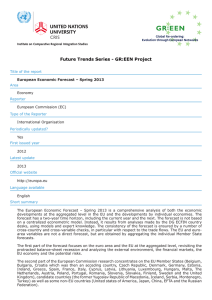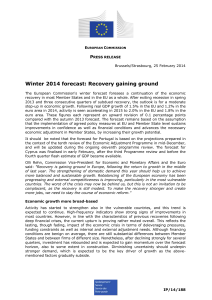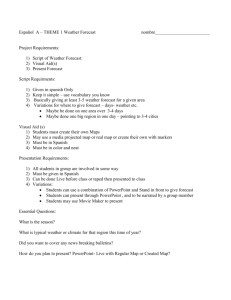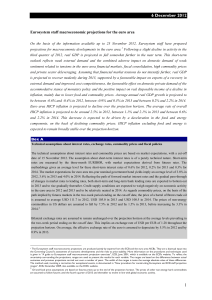DOC - Europa
advertisement
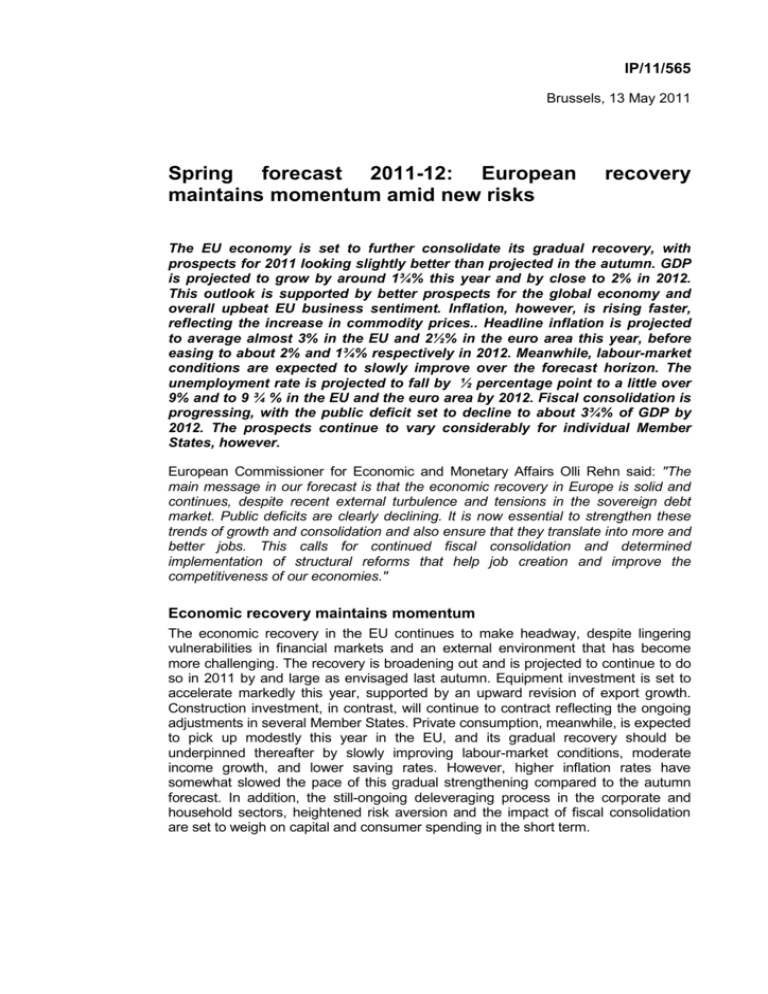
IP/11/565 Brussels, 13 May 2011 Spring forecast 2011-12: European maintains momentum amid new risks recovery The EU economy is set to further consolidate its gradual recovery, with prospects for 2011 looking slightly better than projected in the autumn. GDP is projected to grow by around 1¾% this year and by close to 2% in 2012. This outlook is supported by better prospects for the global economy and overall upbeat EU business sentiment. Inflation, however, is rising faster, reflecting the increase in commodity prices.. Headline inflation is projected to average almost 3% in the EU and 2½% in the euro area this year, before easing to about 2% and 1¾% respectively in 2012. Meanwhile, labour-market conditions are expected to slowly improve over the forecast horizon. The unemployment rate is projected to fall by ½ percentage point to a little over 9% and to 9 ¾ % in the EU and the euro area by 2012. Fiscal consolidation is progressing, with the public deficit set to decline to about 3¾% of GDP by 2012. The prospects continue to vary considerably for individual Member States, however. European Commissioner for Economic and Monetary Affairs Olli Rehn said: "The main message in our forecast is that the economic recovery in Europe is solid and continues, despite recent external turbulence and tensions in the sovereign debt market. Public deficits are clearly declining. It is now essential to strengthen these trends of growth and consolidation and also ensure that they translate into more and better jobs. This calls for continued fiscal consolidation and determined implementation of structural reforms that help job creation and improve the competitiveness of our economies." Economic recovery maintains momentum The economic recovery in the EU continues to make headway, despite lingering vulnerabilities in financial markets and an external environment that has become more challenging. The recovery is broadening out and is projected to continue to do so in 2011 by and large as envisaged last autumn. Equipment investment is set to accelerate markedly this year, supported by an upward revision of export growth. Construction investment, in contrast, will continue to contract reflecting the ongoing adjustments in several Member States. Private consumption, meanwhile, is expected to pick up modestly this year in the EU, and its gradual recovery should be underpinned thereafter by slowly improving labour-market conditions, moderate income growth, and lower saving rates. However, higher inflation rates have somewhat slowed the pace of this gradual strengthening compared to the autumn forecast. In addition, the still-ongoing deleveraging process in the corporate and household sectors, heightened risk aversion and the impact of fiscal consolidation are set to weigh on capital and consumer spending in the short term. As it is typically the case with recoveries from deep financial crises, the EU's recovery is expected to be more muted than in previous upturns, though as private domestic demand gradually strengthens, the recovery will become increasingly selfsustaining. In terms of annual averages, GDP growth is expected to edge up from just above 1½% in the euro area and 1¾% in the EU this year to around 2% in both regions in 2012. The 2011 figures are slightly higher than expected in the previous comprehensive forecast of last autumn. Varied developments across Member States The aggregate picture masks marked differences in developments across Member States. Some countries, in particular Germany, but also some smaller exportoriented economies, have registered a solid rebound in activity, while others, notably some peripheral countries, are lagging behind. It is expected that the pace of recovery within the EU will continue to vary. The ongoing correction of Intra-EU imbalances is set to continue over the forecast horizon. The adjustment is most marked in countries where deficits were very large at the onset of the crisis, to a large extent owed to a retrenchment in consumption. But also some structurally high current-account surpluses appear gradually to be coming down in view of stronger domestic demand and dynamic imports. Rather jobless recovery ahead, but public finances continue to improve The situation in European labour markets continues to be diverse, with the rate of unemployment ranging from 4-5% in the Netherlands and Austria to 17-21% in Spain and the Baltic States. Employment in the EU increased slightly in the last quarter of 2010, driven by improvements in all sectors, except industry and construction. Taking into account the usual lag between output and employment growth, employment is projected to improve modestly in both regions this year. The outlook for unemployment is for a decline of some ½ pp. over the forecast horizon in both regions. However, despite brightening somewhat since the autumn, the outlook remains for a rather jobless recovery. Public finances begun to improve last year. On account of stronger growth and the end of the temporary stimulus measures, the general government deficit in the EU is projected to fall from about 6½% of GDP in 2010 to around 4¾% in 2011 and 3¾% in 2012, with a broadly similar pattern but at a somewhat lower level for the euro area. This is slightly more favourable than envisaged in the autumn. Spending cuts form the bulk of the adjustment in both regions. The debt ratio, in contrast, remains on an increasing path over the forecast horizon, reaching some 83% of GDP in the EU and 88% in the euro area by 2012. Inflation heading higher Relatively high consumer-price inflation is on the cards in both the EU and euro area over the coming period, though far lower than during the 2008 spike. Induced mainly by higher energy inflation, HICP inflation is projected to average almost 3% in the EU and 2½% in the euro area this year, before easing to about 2% and 1¾% respectively in 2012. The still sizeable slack in the economy is expected to keep both wage growth and underlying inflation in check, partly offsetting expected increases in energy and commodity prices. 2 Downside risks to growth prevailing amid increased uncertainty Political changes in the Middle East and North Africa and the economic fallout of the earthquake and tsunami in Japan have heightened uncertainty and constitute downside risks to global economic activity, with the potential to lead to globally higher inflation and lower growth than incorporated in the baseline. Financial markets, particularly some sovereign-bond segments, remain fragile, and damaging negative feedback loops cannot be totally excluded. Risks from tensions in exchange–rate markets are also present. On the upside, stronger-than-assumed global growth, as a result of stronger domestic demand in emerging markets, could further benefit EU export growth. Domestically, the rebalancing of EU GDP growth towards domestic demand could prove stronger than assumed in the forecast with, for instance, the labour market surprising positively. Similarly, there could be greater than expected spillovers from the strong momentum in Germany to other Member States. All in all, the balance of risks for the economic growth outlook presented in this forecast is clearly tilted to the downside. The detailed report is available at: http://ec.europa.eu/economy_finance/eu/forecasts/2011_spring_forecast_en.htm 3 4 5 6 7
